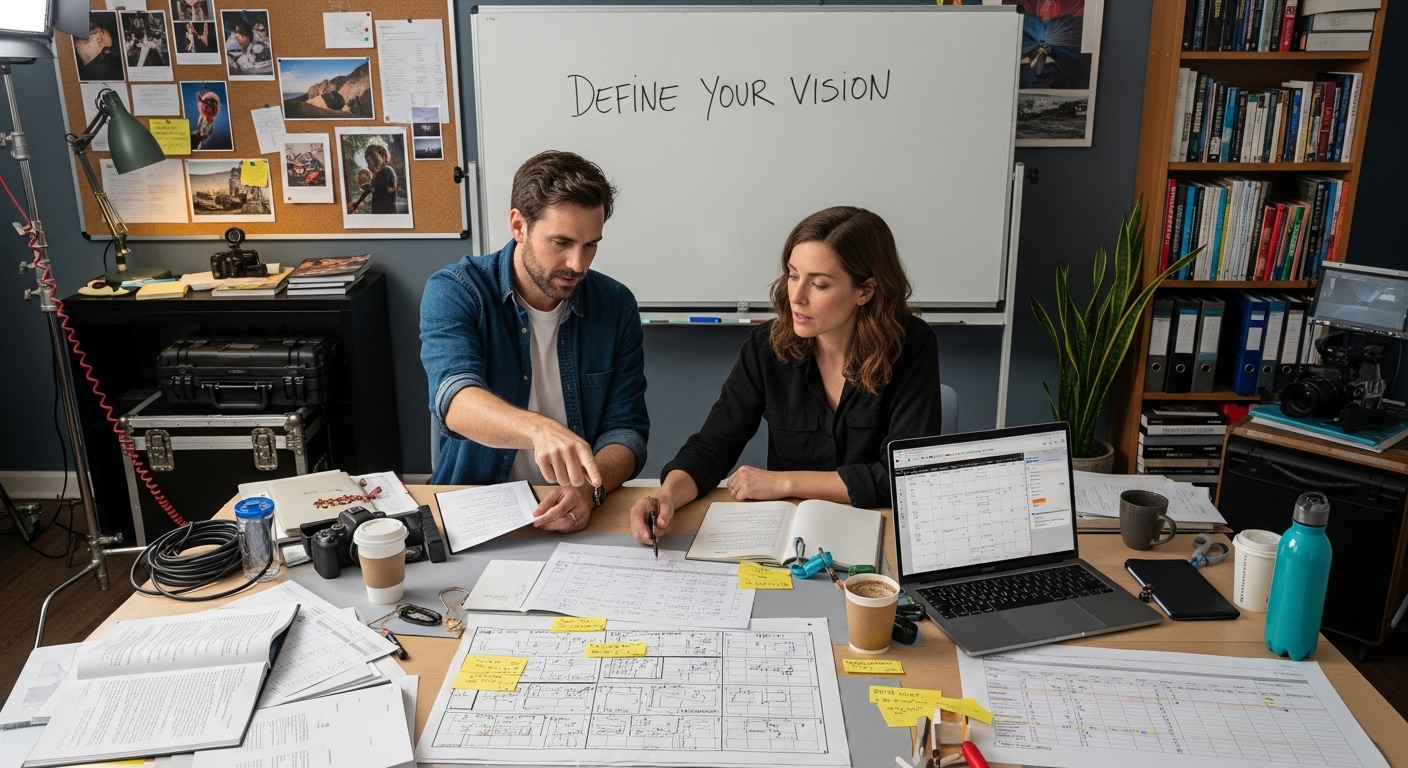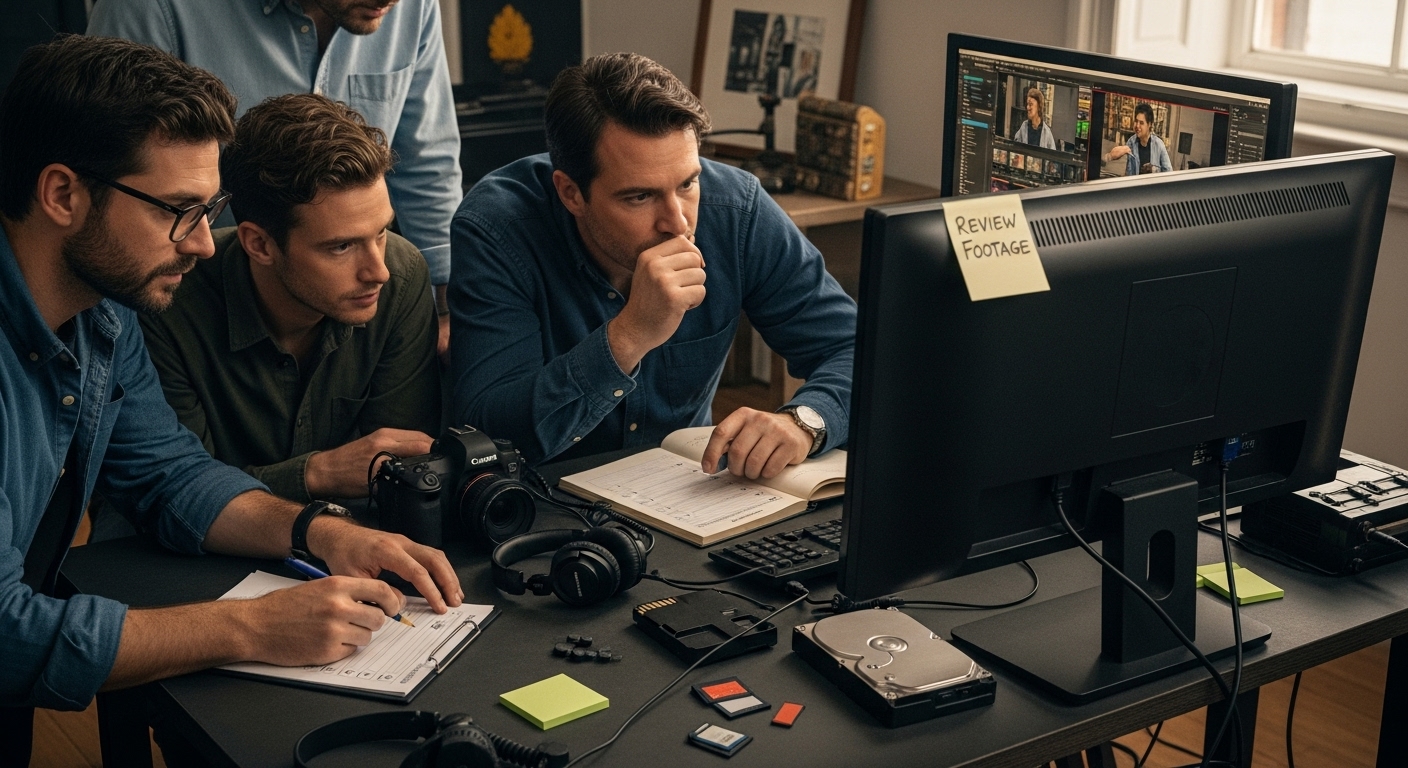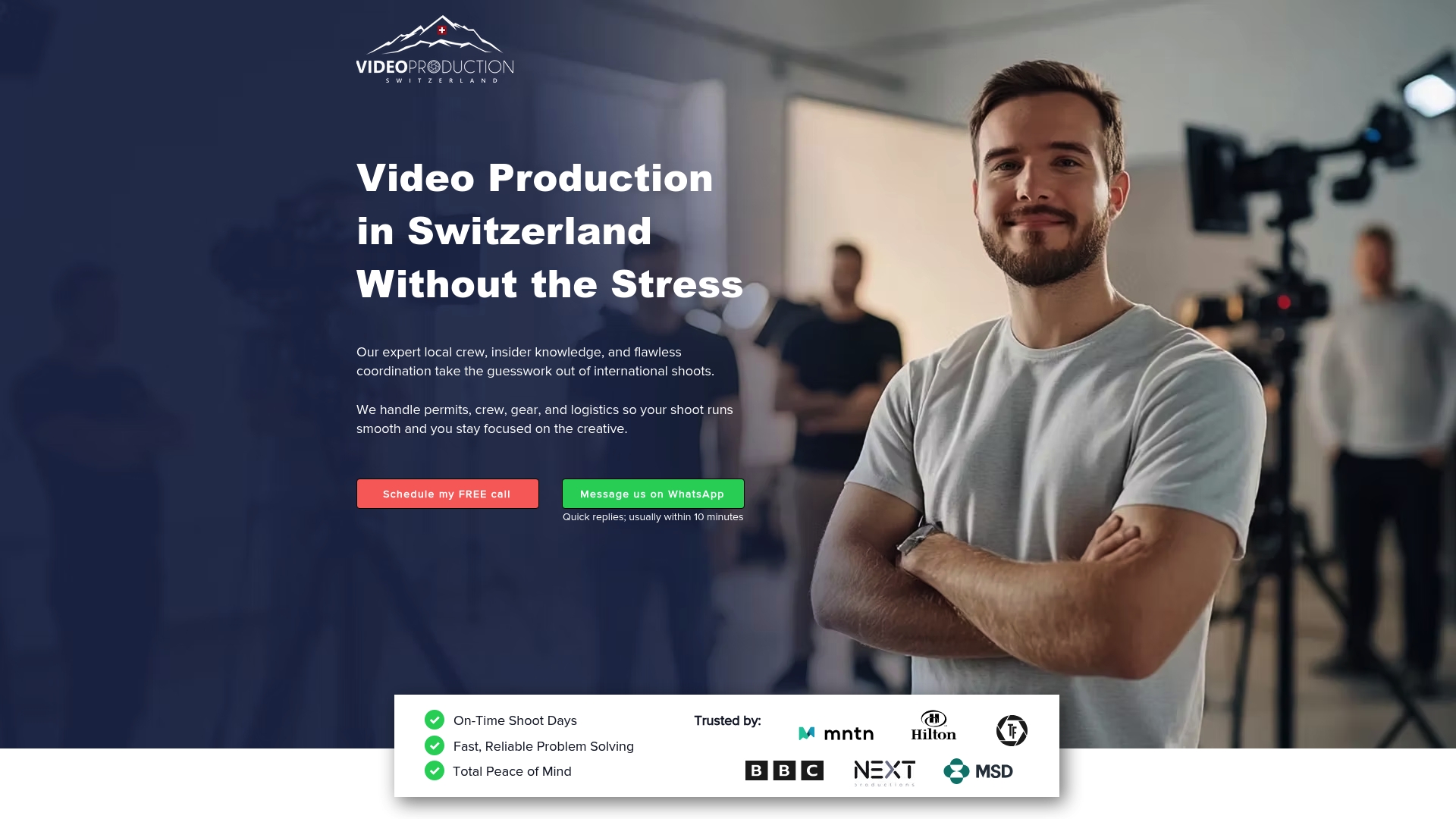How to Plan a Film Shoot: Achieve Production Success
- info1419758
- Sep 16
- 10 min read

Planning a film can feel overwhelming when there are so many moving parts to keep track of. Around 90 percent of production errors are traced back to issues in the early planning stages. Oddly enough, many filmmakers spend more time obsessing over their camera gear than nailing down a clear vision. Shifting your focus to meticulous preparation up front can save you months of frustration—and set you up for a production where creativity actually has space to thrive.
Table of Contents
Quick Summary
Key Point | Explanation |
1. Clearly define your film’s vision | Establish your film’s core purpose and audience to guide production decisions effectively. |
2. Create a detailed production schedule | Break down your script and manage resources, ensuring a structured filming process. |
3. Assemble a competent production team | Recruit key roles with complementary skills and establish clear communication for success. |
4. Conduct thorough location scouting | Assess each location for suitability, incorporating technical requirements and logistical access. |
5. Execute with adaptability during shoots | Balance planning with flexibility, preparing for real-time challenges and ensuring communication. |
Step 1: Define Your Film’s Vision and Objectives
Before you start setting up equipment or scouting locations, every successful film production begins with a clear and compelling vision. Defining your film’s core objectives is the critical foundation that will guide every subsequent decision in your production process.
Start by asking yourself fundamental questions that will crystallize your film’s purpose. What story are you truly trying to tell? Who is your target audience? What emotional response or message do you want viewers to experience? These aren’t just abstract considerations they’re the roadmap that will shape your entire creative and logistical approach.
Develop a concise yet comprehensive creative treatment that articulates your film’s narrative arc, visual style, and thematic core. This document should be detailed enough to communicate your vision to potential collaborators but flexible enough to allow creative interpretation. According to University of Rhode Island’s Film Media program, a strong treatment demonstrates understanding of pre-production processes and helps translate your creative concept into practical production strategies.
Your vision statement should encompass both artistic and practical elements. Consider the practical constraints and opportunities you’ll encounter, such as budget limitations, potential shooting locations, technical requirements, and the skills of your available crew. A realistic vision balances creative ambition with practical executable planning.
To verify you’ve successfully defined your film’s vision, check that you can answer these key questions with clarity and conviction:
What is the central narrative or message of your film?
Who is your primary audience?
What unique perspective or style will distinguish your project?
What are the specific emotional or intellectual responses you want to evoke?
Remember, a well-defined vision isn’t a rigid constraint but a dynamic framework that provides direction while allowing creative flexibility. By investing time in this crucial first step, you’ll create a solid foundation that will streamline every subsequent phase of your film production journey.
Step 2: Create a Detailed Production Schedule
A meticulously crafted production schedule is the architectural blueprint that transforms your creative vision into a realistic filming strategy. Without a comprehensive schedule, even the most brilliant film concept can dissolve into chaos and missed opportunities.
Begin by breaking down your script into precise, manageable segments. Each scene requires careful consideration of time, resources, location requirements, and cast availability. Professional filmmakers typically use specialized scheduling software like Movie Magic Scheduling or more accessible tools like Google Sheets to map out every production detail systematically.
According to ScreenSkills production guidelines, your production schedule should strategically group scenes by location, actor availability, and technical complexity. This approach minimizes unnecessary company moves, reduces overall production costs, and maximizes efficiency. For instance, if you’re shooting multiple scenes in the same location, schedule those consecutively to minimize setup and breakdown time.
Consider creating a color-coded visual timeline that tracks multiple production elements simultaneously. Key components to track include shooting dates, location availability, actor call times, equipment needs, and potential contingency windows. This multi-layered approach allows you to quickly identify potential scheduling conflicts and proactively develop alternative plans.
Realistic time allocation is crucial. Always build buffer time into your schedule for unexpected challenges like equipment malfunctions, weather interruptions, or performance retakes. A good rule of thumb is to add 20-30% additional time beyond your initial estimated shoot duration.

To verify your production schedule’s effectiveness, check that you can confidently answer these critical questions:
Have you accounted for every scene’s unique logistical requirements?
Does your schedule minimize unnecessary production complexity?
Have you built sufficient contingency time into the timeline?
Can all key personnel meet the proposed schedule?
Remember, a production schedule is a living document. While precision is important, flexibility and adaptability are equally crucial in navigating the dynamic landscape of film production.
Step 3: Assemble Your Production Team and Resources
Building a stellar film production team is like conducting an intricate orchestra where each musician plays a critical role in creating a harmonious performance. Your team’s collective expertise and chemistry will ultimately determine the success of your film project.
Start by identifying the core roles that are essential to your production. According to Yale College Arts production guidelines, the foundational team typically includes a Producer, Director, Director of Photography (DP), and Assistant Director. Each role carries specific responsibilities that contribute to the project’s overall vision and execution.
The Producer serves as the strategic backbone of the production, managing budgets, coordinating logistics, and ensuring the project remains on track. Your DP translates the creative vision into visual language, making critical decisions about camera techniques, lighting, and overall aesthetic. The Assistant Director acts as the operational conductor, managing daily schedules, coordinating crew movements, and maintaining production efficiency.
Networking and professional recommendations are invaluable when assembling your team. Reach out to film school alumni, attend industry events, and leverage online platforms like LinkedIn or specialized film production job boards to connect with talented professionals. Look for team members who not only possess technical skills but also demonstrate adaptability, collaborative spirit, and a genuine passion for storytelling.
Resource allocation is equally crucial. Beyond human talent, you’ll need to secure necessary equipment, such as cameras, lighting packages, sound recording gear, and post-production tools. Consider whether you’ll rent, purchase, or leverage existing equipment through production house partnerships.
To verify you’ve successfully assembled your production team and resources, confirm you have:
Identified and recruited key team members with complementary skills
Established clear communication channels and role expectations
Secured all necessary production equipment and backup resources
Created a comprehensive contact list with professional and emergency information
Remember that team chemistry and mutual respect are as important as individual technical abilities. A cohesive team that communicates effectively can transform challenging production scenarios into creative opportunities.
Step 4: Scout Locations and Finalize Shooting Sites
Location scouting is the visual translation of your film’s narrative landscape, transforming script descriptions into tangible, cinematic spaces. Selecting the right locations can elevate your film from ordinary to extraordinary, while poor choices can derail even the most meticulously planned production.
Begin by creating a comprehensive location breakdown that matches each scene’s specific requirements. Analyze your script with a critical eye, identifying not just the obvious environmental needs but also subtle technical considerations. According to the New York Film Academy’s location scouting guidelines, key factors include assessing space for equipment, understanding ambient noise levels, and evaluating lighting conditions throughout different times of day.
Practical preparation is crucial during location scouts. Bring a detailed checklist that includes measuring spaces, testing acoustics, evaluating electrical capabilities, and assessing potential sound interference. Take extensive photographs and video recordings from multiple angles, which will help your production team visualize setup possibilities and potential challenges. Create a location dossier for each potential site, documenting specifics like parking availability, nearby facilities, potential permitting requirements, and logistical access points.
Negotiate and secure location permissions well in advance. This involves communicating with property owners, local authorities, and potentially obtaining film permits. Some locations may require insurance documentation, location fees, or specific scheduling constraints. Always have backup location options in case your primary choices become unavailable or prove logistically challenging.
Consider the practical implications of each location beyond aesthetic appeal. Evaluate factors such as:
Proximity to production base camp
Accessibility for cast and crew
Power and technical infrastructure
Potential weather and environmental challenges
Cost of location rental and associated expenses
To verify you’ve successfully completed location scouting, confirm you have a comprehensive location package that includes detailed site assessments, permissions, backup options, and a clear understanding of each location’s specific production requirements.
Below is a checklist table summarizing the key verification steps to confirm successful location scouting as described in the article.
Item to Verify | Description |
Comprehensive location package | Includes detailed site assessments and photographs |
Secured permissions | Written permission from property owners and authorities |
Backup location options | Alternative sites identified in case of primary site issues |
Accessibility and logistics | Cast, crew, equipment, and base camp access confirmed |
Technical requirements assessed | Power, sound, lighting, and space for equipment evaluated |
Permit and insurance documentation | All necessary permits and insurance forms acquired |
Cost and scheduling considerations | Location fees, rental costs, and scheduling constraints documented |
Remember that thorough location scouting is an investment that can significantly streamline your actual shooting process. |
Step 5: Execute the Shoot According to Plan
The moment of truth arrives when your meticulously crafted plans transform into actual film production. Executing your shoot requires a delicate balance of rigid preparation and adaptive flexibility, where your ability to remain calm and strategic will determine the day’s success.
According to Columbia University’s production protocols, professional film shoots demand rigorous adherence to planning while maintaining the capacity to adjust dynamically. Begin each shooting day with a comprehensive crew briefing that reviews the day’s specific objectives, potential challenges, and precise expectations for every team member.
Communication is the lifeline of a successful film shoot. Establish clear, concise communication channels using tools like walkie-talkies, dedicated communication apps, or predetermined hand signals. Your Assistant Director should function as the primary coordination hub, ensuring smooth transitions between setups, managing time efficiently, and keeping the entire production moving with precision.
Prioritize safety and technical quality throughout the shoot. Conduct thorough equipment checks before starting, verify that all safety protocols are in place, and maintain a professional environment that respects both creative vision and crew well-being. Pay meticulous attention to continuity details, ensuring consistent lighting, actor positioning, and environmental elements across different takes and shooting sequences.
Be prepared to make real-time decisions when unexpected challenges emerge. Weather changes, equipment malfunctions, or performance inconsistencies will test your problem-solving skills. Always have contingency plans and backup strategies ready, allowing you to pivot quickly without losing momentum.
Key elements to monitor during shoot execution include:
Adherence to shooting schedule
Technical equipment performance
Actor and crew energy and performance levels
Scene continuity and quality
Budget and resource management
To verify successful shoot execution, confirm you have comprehensive documentation of each day’s progress, including shot lists, performance notes, technical logs, and any deviation from the original plan. Remember that professional filmmaking is as much about graceful adaptation as it is about meticulous planning.
Step 6: Review Footage and Ensure Quality Control
The review and quality control phase is where raw creativity transforms into polished cinematic art. Your meticulous attention during this stage can elevate good footage into an extraordinary visual narrative, separating professional productions from amateur attempts.
According to University of North Georgia’s video production guidelines, the quality control process demands rigorous technical and creative evaluation. Begin by creating a systematic review workflow that allows you to examine footage comprehensively. This involves watching every single take multiple times, focusing on different technical and performance aspects during each review pass.
Technical quality assessment requires a discerning eye and professional tools. Utilize high-resolution monitors calibrated for color accuracy, and review footage at full resolution to identify subtle imperfections that might be missed on smaller screens. Check critical elements such as focus, exposure, color balance, sound quality, and frame composition. Pay special attention to continuity between shots, ensuring consistent lighting, actor positioning, and environmental details across different scenes.
Performance review is equally crucial. Analyze actor performances not just for emotional authenticity, but also for technical consistency. Look for subtle variations in dialogue delivery, physical movements, and emotional nuance that might require additional takes or creative editing solutions. Your goal is to select takes that not only meet technical standards but also capture the most compelling emotional moments.
Create a comprehensive tracking system for your footage review process. Document strengths, weaknesses, and potential reshoot requirements for each scene.
The following table provides a checklist of elements to evaluate during your footage review and quality control process, as outlined in the guide.
Element | What to Check For |
Technical image quality | Ensure resolution, focus, and exposure meet standards |
Audio clarity and sync | Verify sound quality and lip-sync accuracy |
Performance consistency | Confirm uniformity in actor delivery and emotion across takes |
Lighting and color balance | Check for even lighting, color accuracy, and visual continuity |
Continuity between shots | Identify any mismatches in props, costumes, or scene flow |
Review documentation | Maintain a detailed log of technical and creative assessments |
This systematic approach will provide clear guidance for post-production editing and help maintain the highest possible production standards. |
Key elements to evaluate during footage review include:
Technical image quality and resolution
Audio clarity and synchronization
Performance consistency
Lighting and color balance
Continuity between shots
To verify successful quality control, confirm you have a detailed review log documenting every scene’s technical and creative assessment, with clear recommendations for post-production refinement. Remember that exceptional filmmaking lies in the details, and your commitment to quality can transform good footage into a memorable cinematic experience.

Remove Film Production Stress and Achieve Flawless Shoots in Switzerland
Are you facing the overwhelming reality of turning a detailed film plan into smooth execution? After mastering steps like location scouting, permit handling, and crew management as discussed in “How to Plan a Film Shoot: Achieve Production Success,” the stress of international logistics, local regulations, and finding reliable partners can still feel daunting. If the idea of lost time, permit headaches, or unreliable gear is keeping you up at night, you are not alone. Many filmmakers share these pain points.

Ready for a seamless film shoot without logistical nightmares? Partner with Video Production Switzerland for local expertise and full support. From rapid permit approvals to vetted crew, expert location scouting, gear rental, and on-ground management, we make professional results and peace of mind possible. Book your free consultation on our homepage, discover what clients are saying, and let us build a custom solution based on your production goals. Now is the perfect time to secure your shoot and ensure nothing stands between your vision and a successful outcome in Switzerland.
Frequently Asked Questions
What is the first step in planning a film shoot?
The first step is to define your film’s vision and objectives, which involves clarifying the story, target audience, and desired emotional response. This foundation guides all subsequent production decisions.
How do I create an effective production schedule for my film?
An effective production schedule can be created by breaking down the script into manageable segments, grouping scenes by location and requirements, and using scheduling tools to minimize complexity and maximize efficiency. Always build in buffer time for unexpected challenges.
What roles should I prioritize when assembling my film production team?
Core roles include a Producer, Director, Director of Photography (DP), and Assistant Director. Each of these roles has specific responsibilities crucial to the film’s vision and execution.
What should I consider when scouting filming locations?
When scouting locations, consider factors such as space for equipment, ambient noise levels, lighting conditions, accessibility for cast and crew, and any potential permitting requirements. Creating a detailed location dossier can help document these elements.

Comments